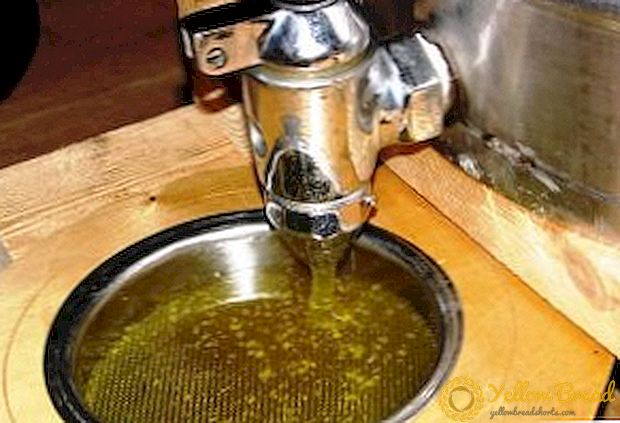 Medogonka - an important tool in the apiary. This mechanism allows you to get fresh honey from the honeycomb.
Medogonka - an important tool in the apiary. This mechanism allows you to get fresh honey from the honeycomb.
Our article is about what medogonki are, how to use them and how to choose, so as not to be mistaken.
- The use of honey extractor in beekeeping
- Types of mechanisms for the location of the cassettes
- Radial
- Chordialnaya
- By drive
- Hand held
- Electric
- By the number of frames
- Criterias of choice
- What to look for
- Secondary characteristics
The use of honey extractor in beekeeping
Honey extractor is necessary for each beekeeper, because the honey collected by bees must be obtained from closed honeycombs.
The device is centrifuge, which consists of a fixed tank, inside which the drum rotates. In the drum there are several movable cassettes where frames with honeycombs are inserted. These cassettes are rotated around its axis by 180 °.
Honeycombs are taken from the hive, opened with a special tool (knife or fork) and placed in the drum. Then it is unwound with the handle, and the honey flows down.
One of the basic principles of such a device is cell conservation intact. After pumping honey they can be used again.
Types of mechanisms for the location of the cassettes
Separation of devices is carried out according to the location of the cassettes where the cells are installed. Allot radial and chordial types of honey extractors.
Radial
In such devices, the cassettes are located along the radius of the drum.
The use of mechanisms of this type is as follows:
- First, the cells are installed so that the bar rests against the top of the cassette.
- After the installation of the last frame, the tank is closed with a lid and they begin to spin the drum.
- The rotation speed is gradually increasing. The duration of continuous rotation is 15 minutes.
- After that, the devastated honeycomb comes from the drum.
The advantage of this location is:
- preservation of the integrity and structure of cells;
- pumping honey from a large number of frames in one go;
- low risk of breaking the honeycomb.

Chordialnaya
In such devices, frames with honey are installed along the chords of the drum circumference. Therefore, the number of cassettes in such devices is limited.
Chordial honey extractors are also divided depending on the mechanism of circulation of the cassettes:
- Non-current - in such devices, pumping is carried out only from the outside of the cells. After that, the content is obtained, turned the other side, and the procedure is repeated.
- Negotiable by hand - on the axis of rotation of the device are mounted hinges, which put the cassette. And now it can be rotated freely first one, then the other side.
- Reversible (negotiable automatically) - The principle is the same as when turning by hand, but the rotation is performed automatically.
- low cost;
- accessibility for households.
- danger of damage to cells by centrifugal force;
- danger of damage due to full pumping. To prevent this, incomplete pumping of honey is carried out, first on one side, then on the other. And only after that all the honey is completely exhausted;
- limited number of cassettes - maximum 4;
- the time of honey pumping from one side is 2-4 minutes.
 Radial mechanisms have many advantages, they are convenient, suitable for large apiaries and industrial farms. The only negative is the price. They are much more expensive than chordial.
Radial mechanisms have many advantages, they are convenient, suitable for large apiaries and industrial farms. The only negative is the price. They are much more expensive than chordial.Chordial same easy to maintain, inexpensive, suitable for owners of a small number of hives. But for large apiaries, they are not acceptable because of their shortcomings.
By drive
The second criterion by which the honey extractors are divided is the type of drive: manual or electric.
Hand held
Such devices are driven by a handle: the most traditional type of honey extractor.
Benefits:
- low cost;
- easy maintenance;
- possibility to use in any conditions.
- low pumping time;
- It is difficult to control the rotation speed - because of this there is a risk of cell damage.

Electric
The rotation of the drum is carried out by an electric motor.Power is supplied either from the mains or from batteries, which allows the mechanism to be used in the field.
Benefits:
- control over the speed and uniformity of rotation;
- control of pumping time;
- fast change of the direction of the movement of cartridges;
- high speed pumping product.
- high cost;
- dependence on energy source;
- complexity of service.

By the number of frames
Devices with a small number of frames (from 2 to 6) - the easiest holiday option for those who have a small amateur apiary. Usually such devices chordial type.
A large number of frames (8-16) - these honey extractors are suitable for large apiaries.
Professional (20 or more) - these will be used by large farms for the production of honey.
Criterias of choice
Medogonki differ in the location of the framework, and the type of drive. How to choose the right device for your farm?
What to look for
The choice of the device for pumping honey should be done on the basis of the quantity of the product that is planned to be obtained. For owners of a small number of bee colonies (up to 10), a two-frame chordial with manual drive is suitable.
Those who have 30 or more hives, you can consider a four-frame. Well, if you plan to produce several tons of product, and you have more than 50 hives, you need a radial honey extractor, preferably with an electric drive. 
Secondary characteristics
Another important criterion is the material of the mechanism. The most popular are aluminum, galvanized steel, and stainless steel.
Stainless steel is most preferred. Such a honey extractor will be more expensive, but safe. This is important for those who plan to sell their products in large quantities.
The market sells a large number of devices for the needs of any consumer. Everyone will be able to choose a mechanism for their apiary - from the smallest to the largest.






